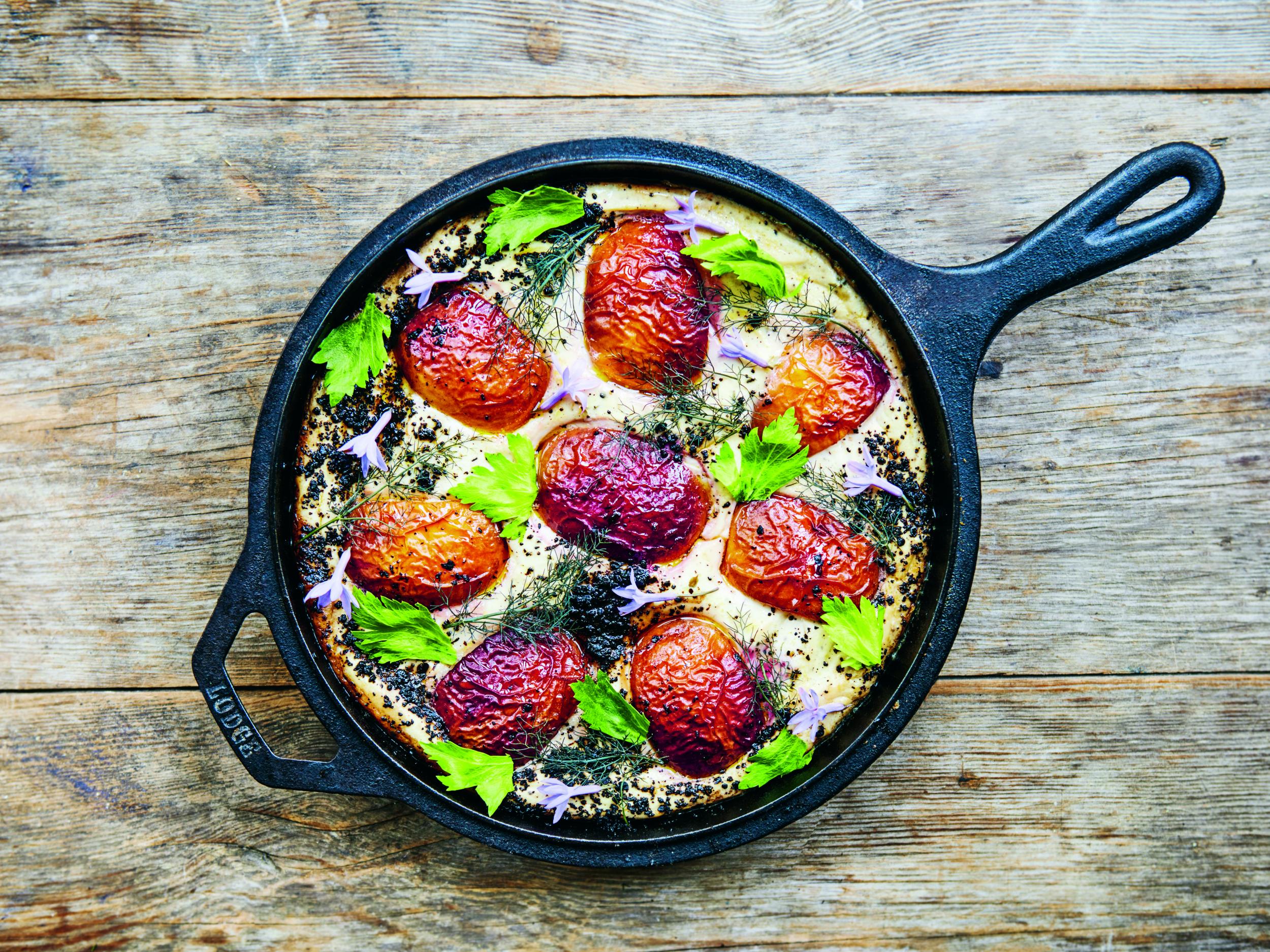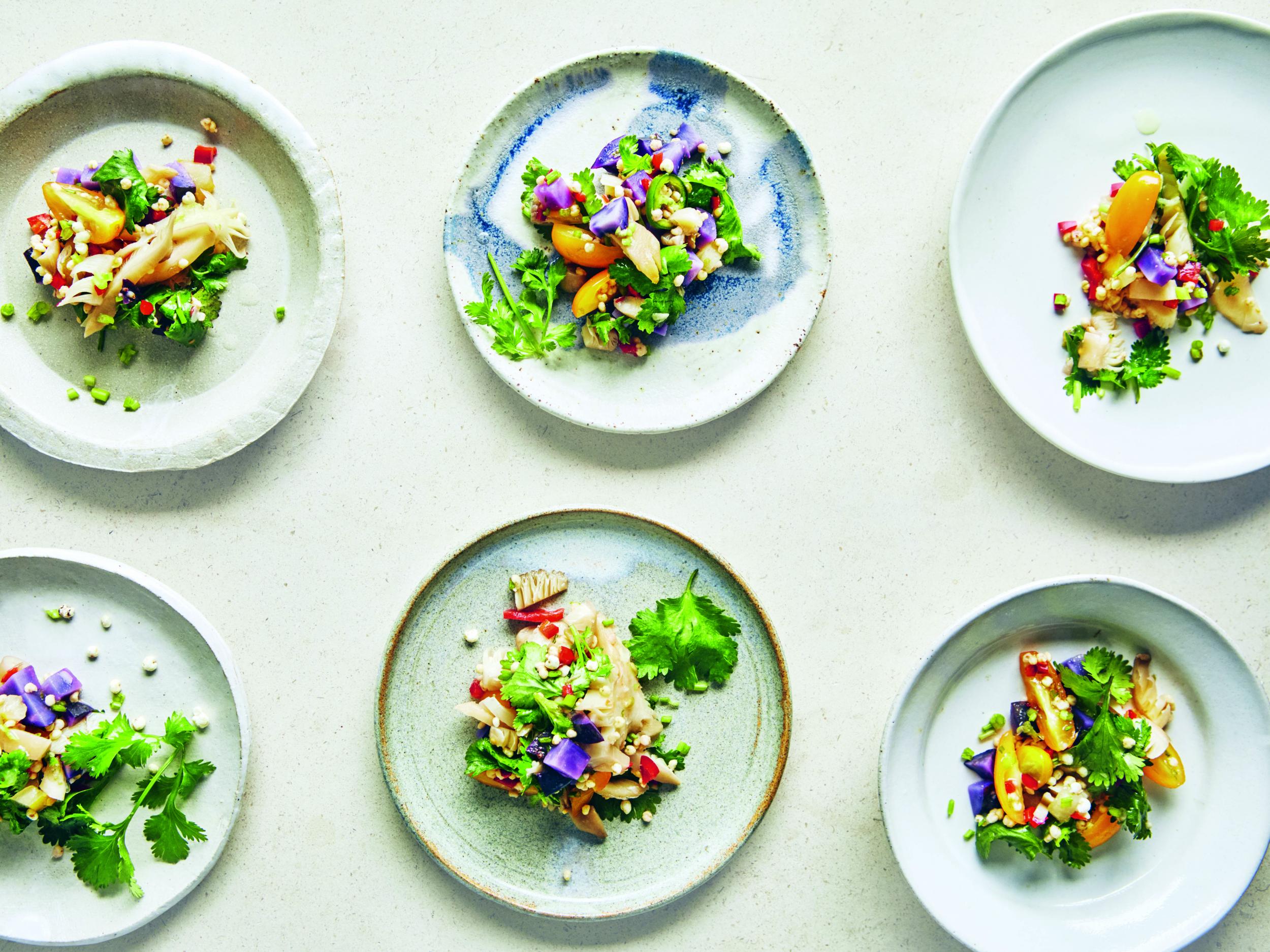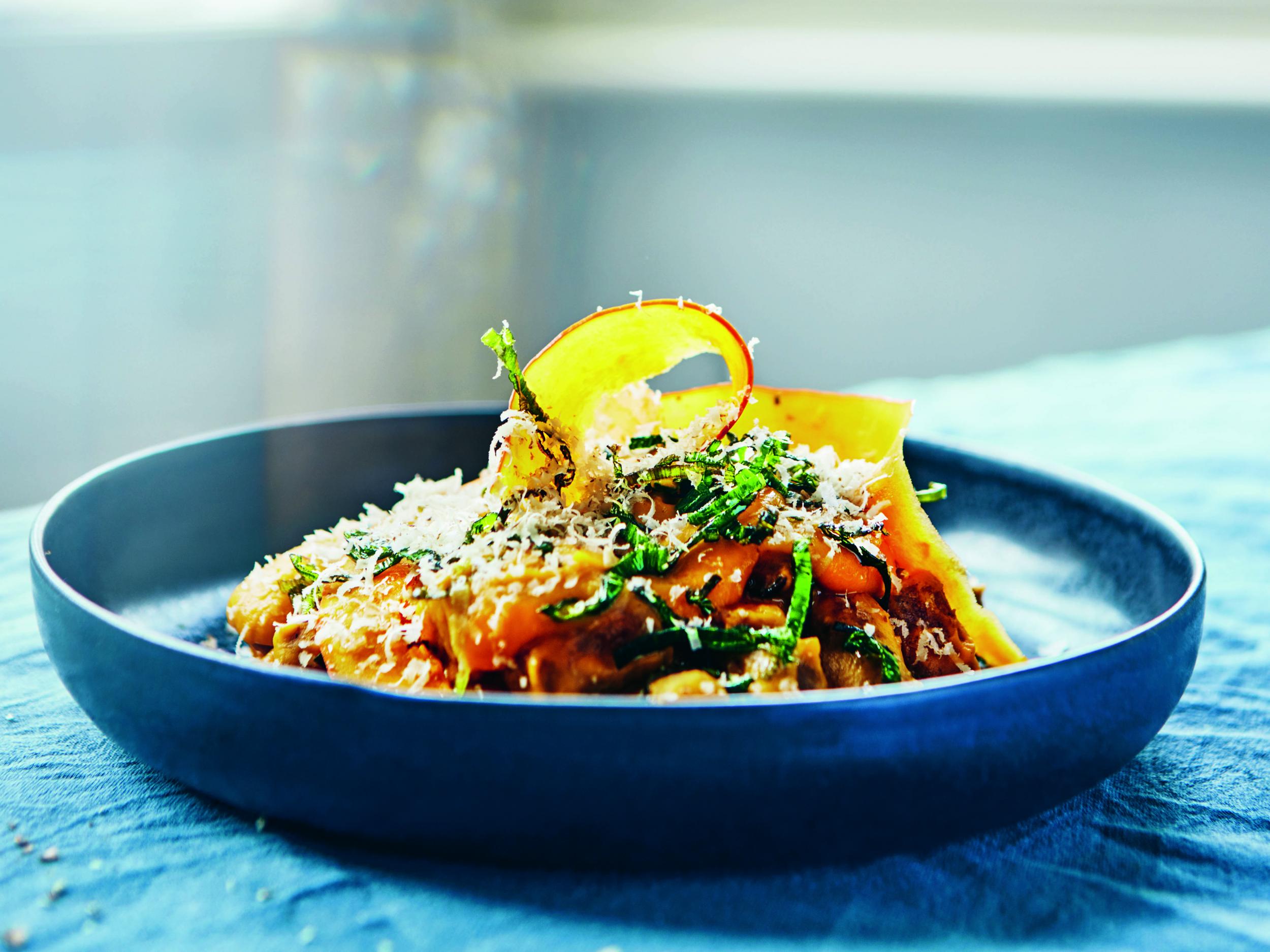Rye gnocchi with squash, crispy leeks and walnuts
Serves 4
Gnocchi is one of the most decadent comfort foods – perfect for winter. In this recipe, finely grated walnuts take the place of cheese and add further depth of flavour. Pumpkin and squash are plentiful at this time of year and very affordable. They come in many varieties, all with their own flavours and characteristics – from vivid, orange-coloured onion squash to squiggly spaghetti squash, which can be shredded into noodle-like strands. Most varieties work well here, so feel free to experiment with what you have available.
I used a beautiful teal-toned Crown Prince. The skin of most squash and pumpkins are more tender than you might think and can be left on when boiling or roasting. The vines, leaves and flowers are also edible and quite nutritious. If you are growing pumpkins yourself, you can harvest the leaves sparingly to use in place of other leafy greens, and the flowers can be stuffed just like courgette flowers or used to finish a dish.
For the gnocchi
500g potatoes (Desiree, King Edward or a similar floury variety)
120g rye or other flour, plus extra for dusting
1 tsp bicarbonate of soda
Glug of extra virgin or light olive oil, for frying
For the squash sauce
380g squash
One-quarter of an unwaxed lemon, zest and juice
2 glugs of extra virgin olive oil
50g leek, finely diced
1 garlic clove, roughly chopped
For the topping
Glug of extra virgin olive oil, for frying
50g green leek tops, washed and sliced into thin strips
4 walnut halves
To make the gnocchi, steam the whole potatoes for 25 minutes or until soft. Drain until very dry, then mash in a bowl. Mix in the flour and bicarbonate of soda and shape into a ball. If the mixture is very sticky, you might need to add a little extra flour.
Split the dough into four equal portions and shape into balls. Dust your work surface lightly with flour, and then roll out each ball to form a long sausage, about 1cm thick. Cut into pieces, approximately 3cm in length, and arrange on a board or tray, lightly dusted with flour. Set aside.
To make the squash sauce, first remove the squash seeds. Leave the skin on and peel 12 long pieces of squash into a bowl and dress with a dash of lemon juice. Cut the remaining squash into 1–2cm cubes.
Heat a glug of oil in a saucepan over a medium-low heat and gently fry the leek until soft, but not coloured. Add the garlic and cook for another minute. Add the squash cubes and pour in 175ml water. Bring to the boil, then cover with a lid and simmer for 15 minutes or until the squash is soft. Blend the squash mixture to a smooth puree with a good glug of extra virgin olive oil and the remaining lemon juice and zest.
To make the crispy leek topping, heat the olive oil in a frying pan over a medium-high heat. Add the leek tops and stir-fry until crisp. Remove from the pan, season with salt and set aside to drain on kitchen paper.
When you are ready to eat, heat a glug of oil in a large frying pan over a medium heat and fry the gnocchi for about 5 minutes, or until they take on a bit of colour. Serve immediately, turned in the warm squash puree and topped with the crispy leeks and squash peelings. Grate over the walnut halves in place of cheese.

Baked labneh with caramelised peaches and chilli flakes
Serves 4
There are an estimated 50,000 pepper varieties in existence, ranging from mild to blow-your-head-off, each with its own complex and distinctive flavour profile. Urfa peppers are a very mild variety grown in Turkey. They have a dark purple-black colour and a smoky raisin-like flavour that lifts this recipe to a whole new level. This is a deeply satisfying dish, not too sweet, not too savoury. Serve it as part of a meze or simply with grilled bread.
Locally grown fruit is often the most perfect, due in part to the short distance it has to travel from farm to table, meaning the delicate fruits can be picked riper – when bought in season – with no need for prolonged storage, which can deplete flavour and nutrition. If you do buy imported soft fruit, check it hasn’t been airfreighted, as this is the most carbon-heavy type of food transportation. Although airfreight is responsible for fewer than 1 per cent of UK food miles, it produces 11 per cent of the carbon dioxide emissions.
1 garlic clove, finely chopped
One-quarter of an unwaxed lemon, zest and juice
8 thyme sprigs, leaves picked
3 tsp urfa chilli flakes, or other extra virgin olive oil, to taste
2–3 peaches or other stone fruit, cut into quarters, stones composted
3 sprigs of fennel fronds or celery leaves
2 tbsp maple syrup, or other sweetener, plus extra to serve
3 sprigs of fennel fronds or celery leaves
Edible flowers, optional
600g labneh (see below)
Yogurt and labneh
Makes 400–500ml
300g any nuts or seeds, soaked for 12 hours, drained, liquid kept
60g active plant-yogurt (either shop-bought, or kept back from a previous batch)
1 tsp sea salt (for savoury labneh)
1 tbsp unrefined sugar or other sweetener (for sweet labneh)
Tip the soaked nuts or seeds into a blender and blitz to a smooth consistency with some of the soaking liquid – the exact quantity will depend on how thick or thin you want your yogurt to be. If you are making labneh, choose a thicker consistency.
For yogurt, blend for 1 minute on maximum setting to make sure the mixture is very smooth. Stir in the active plant- yogurt, pour into a sealed container and set aside in the fridge overnight.
For labneh, stir the salt or sugar/sweetener into the yogurt, then pour into a sieve lined with muslin or a clean tea towel over a bowl. Place in the fridge for 3–6 hours to firm up. Store the nut-yogurt or labneh in the fridge for 1–2 weeks.
Preheat the oven to 180C.
In a large bowl, mix together the labneh, garlic, lemon zest and juice, half of the thyme leaves, one teaspoon of the chilli flakes and a little extra virgin olive oil. Turn the mixture into an enamel dish or pan and level out the surface with a knife. Arrange the peach quarters on top, sprinkle with the remaining chilli flakes and drizzle with the maple syrup or other sweetener. Bake for 35 minutes or until coloured.
To serve, sprinkle with the remaining thyme leaves and a scattering of fennel fronds or celery tops and edible flowers, if using.

Summer veg ceviche
Serves 4 as a side dish, light lunch or starter
Ceviche is a Peruvian salad made of raw fish or vegetables, dressed with a zesty and piquant liquid called “tiger’s milk”. It is usually made with lime juice and a chilli called aji amarillo, which you can buy in specialist shops or online. With the purple potatoes, yellow tomatoes and green coriander, this dish is vibrant and rainbow coloured.
The white oyster mushrooms act like sponges, absorbing the punchy tiger’s milk to create a refreshing salad that is perfect on a hot summer’s day.
Oyster mushrooms are part of an urban farming revolution that has been taking place over the last couple of decades, transforming city spaces into flourishing edible gardens.
Cultivated mushrooms need relatively few resources to thrive. They grow in small dark spaces like shipping containers on composted and recycled materials like used coffee grounds (which we produce 7 million tons of a year) and wood shavings, which are then upcycled into fertile potting compost. You can even buy home kits to grow them yourself.
50g purple potatoes, diced into 1cm cubes
4 tbsp puffed grain (eg amaranth, quinoa, rice)
60g oyster mushrooms, thinly sliced
100g cherry tomatoes (yellow if available), quartered
Dried aji amarillo or fresh chilli, finely diced, to taste
1 unwaxed lime or half an unwaxed lemon, zest and juice
3 fresh coriander sprigs, leaves picked, stalks finely chopped

Blanch the potato cubes in a pan of boiling water for 10 minutes, then drain and set aside to cool.
To finish, mix everything and season with salt to taste, saving a few of the puffed grains and coriander leaves to finish the dish. Serve immediately or set aside to macerate for an hour.
‘Eating for People, Pleasure & Planet‘ by Tom Hunt is published by Kyle Books, £26, octopusbooks.co.uk; photography: Jenny Zarins

Join our commenting forum
Join thought-provoking conversations, follow other Independent readers and see their replies
Comments